Metastatic cancer cell attachment to endothelium is promoted by endothelial glycocalyx sialic acid degradation
- PMID: 31367063
- PMCID: PMC6668365
- DOI: 10.1002/aic.16634
Metastatic cancer cell attachment to endothelium is promoted by endothelial glycocalyx sialic acid degradation
Abstract
While it is known that cancer cell interactions with vascular endothelial cells (ECs) drive metastatic cancer cell extravasation from blood vessels into secondary tumor sites, the mechanisms of action are still poorly understood. Here, we tested the hypothesis that neuraminidase-induced degradation of EC surface glycocalyx (GCX), particularly the sialic acid (SA) residue components of the GCX, will substantially increase metastatic cancer cell attachment to ECs. To our knowledge, our study is the first to isolate the role of GCX SA residues in cancer cell attachment to the endothelium, which were found to be differentially affected by the presence of neuraminidase and to indeed regulate metastatic cancer cell homing to ECs. We hope that this work will eventually translate to identification of EC GCX-based cancer markers that can be therapeutically targeted to hinder the progression of metastasis.
Keywords: endothelial glycocalyx; metastatic cancer cells; secondary tumor; sialic acid.
Figures


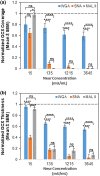
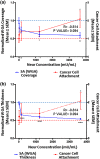
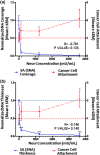
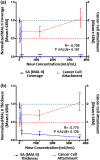
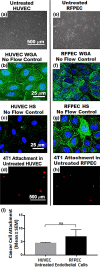
Similar articles
-
Endothelial Glycocalyx-Mediated Intercellular Interactions: Mechanisms and Implications for Atherosclerosis and Cancer Metastasis.Cardiovasc Eng Technol. 2021 Feb;12(1):72-90. doi: 10.1007/s13239-020-00487-7. Epub 2020 Sep 30. Cardiovasc Eng Technol. 2021. PMID: 33000443 Free PMC article. Review.
-
Flow-regulated endothelial glycocalyx determines metastatic cancer cell activity.FASEB J. 2020 May;34(5):6166-6184. doi: 10.1096/fj.201901920R. Epub 2020 Mar 13. FASEB J. 2020. PMID: 32167209 Free PMC article.
-
Glycocalyx in Atherosclerosis-Relevant Endothelium Function and as a Therapeutic Target.Curr Atheroscler Rep. 2017 Nov 10;19(12):63. doi: 10.1007/s11883-017-0691-9. Curr Atheroscler Rep. 2017. PMID: 29127504 Free PMC article. Review.
-
Endothelial barrier reinforcement relies on flow-regulated glycocalyx, a potential therapeutic target.Biorheology. 2019;56(2-3):131-149. doi: 10.3233/BIR-180205. Biorheology. 2019. PMID: 30988234 Free PMC article. Review.
-
Ultrasmall gold nanorods: synthesis and glycocalyx-related permeability in human endothelial cells.Int J Nanomedicine. 2019 Jan 17;14:319-333. doi: 10.2147/IJN.S184455. eCollection 2019. Int J Nanomedicine. 2019. PMID: 30697044 Free PMC article.
Cited by
-
Adhesion and Stiffness of Detached Breast Cancer Cells In Vitro: Co-Treatment with Metformin and 2-Deoxy-d-glucose Induces Changes Related to Increased Metastatic Potential.Biology (Basel). 2021 Sep 4;10(9):873. doi: 10.3390/biology10090873. Biology (Basel). 2021. PMID: 34571750 Free PMC article.
-
Lectin Staining of Microvascular Glycocalyx in Microfluidic Cancer Cell Extravasation Assays.Life (Basel). 2021 Feb 25;11(3):179. doi: 10.3390/life11030179. Life (Basel). 2021. PMID: 33668945 Free PMC article.
-
Endothelial Glycocalyx-Mediated Intercellular Interactions: Mechanisms and Implications for Atherosclerosis and Cancer Metastasis.Cardiovasc Eng Technol. 2021 Feb;12(1):72-90. doi: 10.1007/s13239-020-00487-7. Epub 2020 Sep 30. Cardiovasc Eng Technol. 2021. PMID: 33000443 Free PMC article. Review.
-
Beta-1,4-galactosyltransferase-3 deficiency suppresses the growth of immunogenic tumors in mice.Front Immunol. 2023 Oct 9;14:1272537. doi: 10.3389/fimmu.2023.1272537. eCollection 2023. Front Immunol. 2023. PMID: 37901252 Free PMC article.
-
Flow-regulated endothelial glycocalyx determines metastatic cancer cell activity.FASEB J. 2020 May;34(5):6166-6184. doi: 10.1096/fj.201901920R. Epub 2020 Mar 13. FASEB J. 2020. PMID: 32167209 Free PMC article.
References
-
- Tian Q, Wang Y, Guo H, et al. Recent perspectives of management of breast cancer metastasis ‐ an update. J BUON. 2017;22(2):295‐300. - PubMed
-
- Sharma R, Sharma R, Khaket TP, Dutta C, Chakraborty B, Mukherjee TK. Breast cancer metastasis: putative therapeutic role of vascular cell adhesion molecule‐1. Cell Oncol (Dordr). 2017;40(3):199‐208. - PubMed
-
- Reymond N, d'Agua BB, Ridley AJ. Crossing the endothelial barrier during metastasis. Nat Rev Cancer. 2013;13(12):858‐870. - PubMed
Grants and funding
LinkOut - more resources
Full Text Sources
